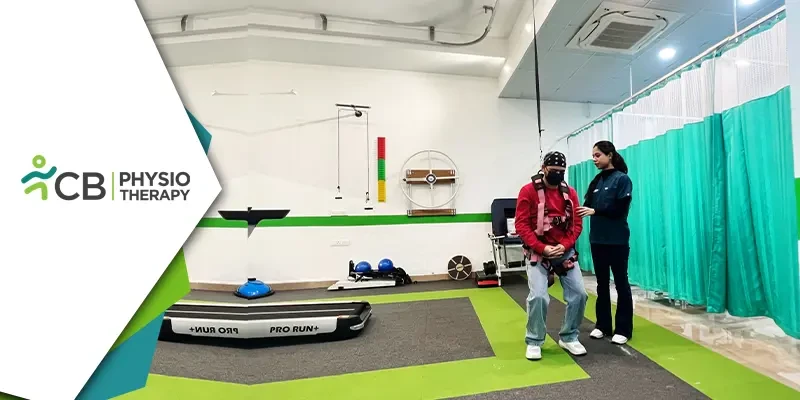In the dynamic world of physiotherapy, innovation is key to maximizing patient outcomes and fostering recovery. Among the latest advancements in assistive technology, the Overhead Track System has emerged as a game-changer in physiotherapy clinics worldwide. At our clinic, we have pioneered our innovative system, Tread-Aid, which similarly attaches to a harness to protect patients from falls and injuries, facilitating a spectrum of therapeutic interventions, including sit-to-stand assistance, walking therapy, balance training, and gait training. Let's explore how this ground-breaking technology, Tread-Aid, is revolutionizing rehabilitation practices and empowering patients, including those with prosthetics, to achieve their mobility goals.
1. Safety and Support with Tread-Aid:
1: Harnessing Safety and Support: The cornerstone of the Tread-Aid system lies in its ability to provide unparalleled safety and support to patients undergoing physiotherapy, including those with prosthetics. By attaching a harness to the overhead track, Tread-Aid ensures that patients are securely stabilized during various therapeutic activities. This not only minimizes the risk of falls and injuries but also instils confidence in patients, including those with prosthetics, as they navigate their rehabilitation journey.2: Sit-to-Stand Assistance: For individuals recovering from injuries or surgeries, the simple act of transitioning from a seated to a standing position can pose significant challenges. The Tread-Aid system offers a lifeline in this regard, allowing patients to perform sit-to-stand maneuvers with ease and confidence. By adjusting the tension and height of the harness, physiotherapists can tailor the level of assistance to meet the specific needs of each patient, facilitating a smoother and more controlled transition.
3: Walking Therapy: Walking is a fundamental component of rehabilitation, promoting strength, coordination, and cardiovascular health. The Tread-Aid system enhances traditional walking therapy by providing patients with a secure support mechanism as they engage in guided walking exercises. Whether recovering from Orthopedic injuries, Neurological conditions, or adapting to prosthetic limbs, patients, can benefit from the stability and confidence afforded by the Tread-Aid system, accelerating their progress towards independent mobility.
4: Balance Training: Maintaining balance is essential for preventing falls and improving overall functional capacity. The Tread-Aid system serves as a versatile platform for balance training exercises, allowing patients, including those with prosthetics, to challenge their equilibrium in a safe and controlled environment. By incorporating dynamic movements and foundation for enhanced mobility and fall prevention.
2. Gait Training and Patient Empowerment:
1: Gait Training: Gait abnormalities are common among individuals recovering from strokes, spinal cord injuries, fractures, sprains, or those adapting to prosthetic limbs. Gait training aims to address these issues by optimizing walking patterns and restoring normal gait mechanics. With the Tread-Aid system, physiotherapists can guide patients through gait training exercises while providing customized support and feedback. By analyzing gait dynamics and adjusting the harness tension accordingly, physiotherapists can help patients improve their stride length, step symmetry, and overall gait efficiency.2: Empowering Patients through Innovation: Beyond therapeutic benefits, this part emphasizes how the Tread-Aid system empowers patients, including those with prosthetics, to actively participate in their rehabilitation journey. Providing a sense of security and independence, the innovative technology instills confidence, enabling patients to push limits and achieve greater mobility milestones. From regaining the ability to stand unassisted to mastering complex walking patterns, tangible improvements in functional abilities enhance overall well-being.
In the realm of physiotherapy, the Tread-Aid system represents a paradigm shift in rehabilitative care for a diverse range of patients, including those with prosthetics. By combining safety, support, and customization, this transformative technology enables physiotherapists to deliver comprehensive and effective interventions. Whether assisting with sit-to-stand transitions, guiding walking therapy sessions, refining balance and gait mechanics, or addressing complex mobility challenges, the Tread-Aid system is revolutionizing rehabilitation practices and empowering patients, including those with prosthetics, to reclaim their independence and mobility. As physiotherapy continues to evolve, this innovative technology promises to play a pivotal role in optimizing patient outcomes and shaping the future of rehabilitative care.
If you or a loved one needs specialized physiotherapy in South Delhi, our dedicated team will support your journey to improved mobility. Contact us now to schedule a consultation and discover how our innovative Tread-Aid system can enhance your rehabilitation.

